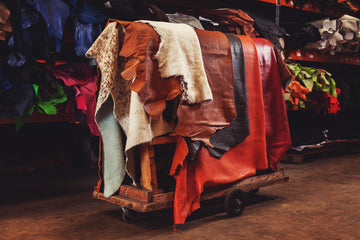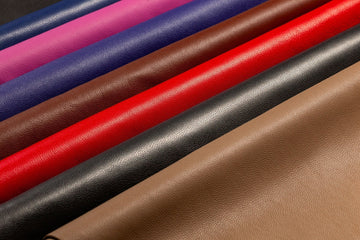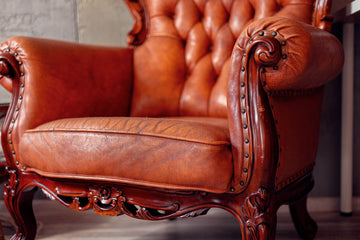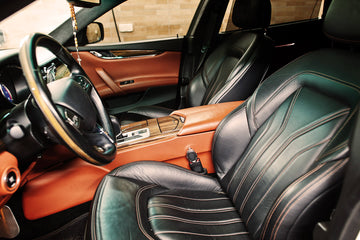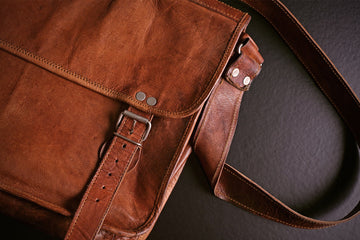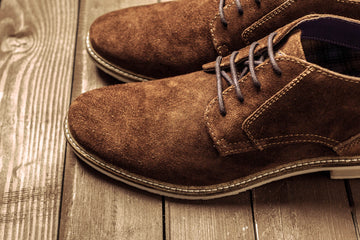Genuine leather is made from animal hides, but it's considered a lower-grade leather. This article will explain what genuine leather is, how it compares to other types of leather, and why understanding these differences matters for your purchases.
Key Takeaways
- Genuine leather, while real, is the lowest quality grade, made from lower layers of animal hides after the higher-quality top grain is removed.
- Genuine leather production involves extensive processing and tanning, often using toxic chemicals like chromium, raising environmental concerns.
- Although more affordable, genuine leather is generally less durable than higher-grade leather, making proper care essential for longevity.
What is Genuine Leather?
Genuine leather, a term often encountered in the marketplace, can be alluring and misleading.
Essentially, genuine leather is made from animal hides but represents the lowest quality grade in the leather classification system. The term "genuine" indicates that:
- The leather has been heavily processed.
-
It is made from the lower layers of the hide after the top grain has been removed.
- It includes split leather and reconstituted leather, among other forms. Additionally, real animal leather comprises various types of leather products.
Unlike full-grain leather, which is the highest quality and retains all the natural characteristics of the animal hide, or top-grain leather, which has had the very top surface sanded away to remove imperfections, genuine leather is derived from the middle and lower layers of animal hides.
This makes genuine leather more affordable and widely available in various retail outlets. However, it also means that genuine leather is generally thinner and may lack higher-grade leathers' distinctive grain patterns and natural beauty.
Knowing where genuine leather stands in the hierarchy of leather grades helps make informed purchasing decisions. Distinguishing genuine leather from other types, such as bonded leather (made from leather scraps and fibres bonded with polyurethane or latex) and synthetic leathers like PU leather and vegan leather, is essential as these are entirely man-made and contain no animal hide.
Recognising these differences allows a better appreciation of genuine leather's qualities and limitations and helps distinguish real leather.
The Process of Making Genuine Leather
Transforming raw animal hides into genuine leather is intricate and multifaceted. It begins with preserving hides to enable their storage and transport. This initial step is crucial as it prevents the hides from decomposing. In the preparatory operations, hides are thoroughly cleaned and treated for tanning.
Tanning is the heart of leather production. This process converts the collagen in the hides into a stable form of leather resistant to microbial degradation.
Different tanning methods can be used, but the most common for genuine leather is chromium salts. While effective, this method raises environmental concerns due to the toxicity of chromium.
After tanning, the wet-end stage involves applying various chemicals and dyes to achieve desired properties and colours, which are often used to describe the leather's aesthetic appeal and functionality.
The finishing stage enhances the leather's appearance and durability with protective coatings. These coatings can also help to mimic the look and feel of higher-grade leathers.
Genuine leather is made from the layers of hide that remain after the top grain has been removed. This means that while it is real leather, it lacks the same durability and aesthetic quality as full-grain or top-grain leather.
Nevertheless, the intricate process it undergoes ensures that genuine leather retains some of the desirable qualities of leather, such as its flexibility and ability to develop a patina over time.
Characteristics of Genuine Leather
Genuine leather exhibits various physical properties that impact its overall appearance and usability. One of the most notable characteristics is its texture and consistency.
Unlike full-grain or top-grain leather, which boast a rich texture and natural grain patterns, genuine leather may feel plasticky or overly smooth. This is due to the extensive processing and finishing it undergoes to enhance its material appearance and durability.
Aesthetically, genuine leather can vary widely. It might not have the unique grain patterns that higher-grade leathers possess. Additionally, it may not showcase the same level of natural beauty. This variability can result in a less luxurious look, making it important for consumers to carefully examine genuine leather items before purchasing.
Despite these differences, genuine leather can still offer sophistication and elegance, especially in fashion items like handbags, belts, and jackets.
Regarding durability, genuine leather is generally less resilient and sturdy than full-grain or top-grain leather, which can lead to misconceptions about its durability. While genuine leather can withstand regular use, it is more prone to wear and tear over time.
Proper care and maintenance can help extend the life of genuine leather items, but they may not offer the same longevity as higher-grade leathers.
Common Misconceptions About Genuine Leather
The term "genuine leather" often misleads consumers into believing they are purchasing a high-quality product. However:
- Products labelled as genuine leather may include those made from split leather, the lowest layer of animal hide.
- This label does not indicate a specific quality or type, often causing confusion among consumers, especially when compared to fake leather.
- Genuine leather can also be made from reconstituted layers of leftover leather glued together.
One common misconception is that genuine leather products are always of high quality. While genuine leather is real leather, it represents a lesser grade than full-grain and top-grain leather.
Items labelled as "genuine leather" may contain only a small percentage of actual leather, causing consumers to disregard the importance of leather grades when making purchases. In this context, the term "genuine" indicates that genuine leather is often heavily processed and made from the hide's lower layers after removing the top grain.
Marketing tactics often emphasise the "genuine" aspect without explaining the quality implications. Many consumers do not understand the leather grading system, leading to disappointment when the product does not meet their expectations.
Consumers must educate themselves about the different grades of leather and others to make informed purchasing decisions and check the label to avoid falling prey to misleading labels.
Advantages and Disadvantages of Genuine Leather
Genuine leather offers a unique balance of quality, durability, and affordability, making it a popular choice for many consumers. However, it also has its limitations. Understanding the pros and cons of genuine leather can help you make an informed decision when choosing leather products.
Affordability
Genuine leather offers a significant advantage due to its affordability. Key points include:
- Genuine leather products cost 50-70% less than full-grain leather equivalents.
- This price difference makes genuine leather an attractive option for consumers looking for quality at a lower price point.
- Genuine leather is affordable, allowing more people to enjoy the luxury of leather goods without breaking the bank. Many people appreciate this cost-effective option.
Consumers should be aware, however, that this lower cost comes with trade-offs in quality. Genuine leather is significantly less expensive than full-grain or top-grain leather but lacks some desirable attributes of higher-grade leather. By understanding these trade-offs, you can make a more informed purchasing decision that aligns with your budget and quality expectations.
Durability
Genuine leather is reasonably durable but less long-lasting than higher-grade leather. Genuine leather products are generally less durable and lower in quality compared to full-grain or top-grain leather.
While genuine leather can withstand regular use, it is more susceptible to wear and tear over time, making it a less favourable choice than options made from durable materials.
If damaged, genuine leather items are often repairable, especially for minor scratches and scuffs. Extensive damage can lead to substantial repairs. In some cases, it might necessitate a complete replacement. Knowing the limitations and drawbacks of genuine leather helps improve care and extend the lifespan of leather products.
Versatility
Genuine leather is known for its versatility and is commonly used in various fashion items. Genuine leather is often suitable for multiple items. Examples include belts, wallets, and casual footwear. The qualities of luxury and sophistication that genuine leather offers make it a popular choice for these products.
Fashion items made from genuine leather include:
- Handbags
- Leather handbag made of real leather
- Leather bags
- Belts
- Shoes
- Jackets
- Wallets
- Various materials
These items benefit from genuine leather's aesthetic appeal and flexibility. Despite being a lower-grade leather, genuine leather can still provide a touch of elegance and style to various products, making it a versatile choice for manufacturers and consumers.
How to Care for Genuine Leather
Proper care and maintenance are crucial for preserving the look and longevity of genuine leather items. Here are some key care tips:
- Regular dusting with a soft cloth can help maintain the leather's appearance.
- Regular cleaning requires a soft, dry cloth or a slightly damp cloth.
- Avoid using harsh chemicals or cleaning agents when cleaning genuine leather.
Applying a nourishing leather balm can help address minor marks on the leather. Regular conditioning prevents the leather from drying out and becoming brittle. Apply conditioner and let it penetrate for a few minutes. Afterwards, use a clean cloth to buff away any excess.
Leather items should be stored with the following considerations:
- Keep them away from direct sunlight and heat.
- Store them ideally in breathable storage bags or wrapped in acid-free tissue paper.
- Avoid storing leather items in plastic bags to ensure proper ventilation.
- Use a leather protector to help prevent stains and maintain the leather's look.
Following these care tips can extend the life of your genuine leather products and keep them looking their best.
Environmental and Ethical Considerations
The leather industry has significant environmental and ethical implications, including:
- The demand for genuine leather contributes to animal agriculture's environmental footprint.
- Animal agriculture, which supplies hides for leather, is a significant contributor to greenhouse gas emissions.
- The leather industry is associated with deforestation as land is cleared for livestock grazing.
The tanning process for leather often involves toxic chemicals like chromium, which can contaminate water sources. Environmental and ethical concerns highlight the importance of considering leather production's impact on the planet. Opting for ethically sourced leather and supporting brands prioritising sustainability helps consumers make environmentally friendly choices.
How to Identify Genuine Leather
Identifying genuine leather can be challenging, but several methods can help distinguish it from faux leather. Check the labels, examine the texture and appearance, and conduct smell tests.
Genuine leather has rough edges due to its fibrous makeup, while synthetic leather has clean, machine-cut edges. Unlike synthetic leather, which exhibits unique grain patterns and imperfections and has a uniform texture, genuine leather has a uniform texture.
Differences between genuine leather and synthetic leather include:
- Genuine leather feels coarse and is warmer to the touch.
- Genuine leather has a distinct smell reminiscent of animal hide.
- Synthetic leather feels cooler and more plastic-like.
- Synthetic leather often has a chemical or plastic odour.
The water absorption test can also help; genuine leather absorbs water, while faux leather causes water to bead on the surface. Bending genuine leather usually results in colour changes and wrinkles, indicating its elasticity, unlike the rigidity of synthetic leather. The water test can provide further insights into these materials.
Why Choose Rolford Leather for Your Genuine Leather Needs?
At Rolford Leather, we understand that choosing the right leather grade for your project is crucial, whether working with genuine leather or seeking premium alternatives.
As the UK's premier leather supplier, we provide complete transparency about leather grades and quality, helping you make informed decisions that match your specific requirements and budget.
Our comprehensive collection spans the entire leather quality spectrum, from cost-effective genuine leather options to premium full-grain hides. Every piece is ethically sourced from trusted suppliers and carefully selected to ensure consistent quality and performance.
With detailed product descriptions and grade classifications, you'll know exactly what you're purchasing. Our expert team guides you through the leather selection process, explaining the differences between genuine, top-grain, and full-grain options for your application.
We offer tailored solutions, from custom cutting services to bulk ordering options, backed by industry expertise and exceptional customer service throughout the UK.
How to Buy Leather Online?
Ready to source the perfect leather for your next project? Whether you need genuine leather for budget-conscious applications or premium grades for luxury items, Rolford Leather makes online purchasing reliable and straightforward.
Please browse our extensive range of colours, textures, and finishes, all categorised by leather grade and quality. Our expert team guides you through the leather selection process, explaining the differences between genuine, top-grain, and full-grain options and types of leather for your specific application, including the highest-quality leather.
We provide tailored solutions, ranging from custom cutting services to bulk ordering options, supported by industry expertise and exceptional customer service across the UK.
Summary
In conclusion, while often misunderstood, genuine leather offers a unique balance of affordability, durability, and versatility. It is made from real animal hides but represents the lowest quality grade in the leather classification system.
Understanding the process of making genuine leather and its characteristics helps make informed purchasing decisions. Despite its limitations, genuine leather remains a popular choice for various fashion items due to its cost-effectiveness and aesthetic appeal.
As we have explored, proper care and maintenance can significantly extend the life of genuine leather products. Additionally, considering leather production's environmental and ethical implications is crucial today.
By choosing ethically sourced leather from reputable suppliers like Rolford Leather, you can enjoy high-quality leather goods while minimising your environmental footprint.
Remember, the key to a satisfying leather purchase lies in understanding the different leather grades and selecting the one that best fits your needs and values.
